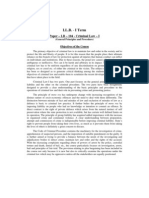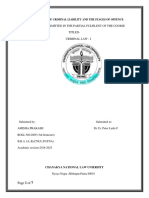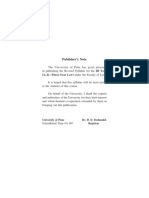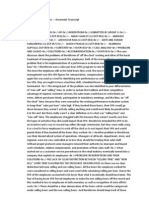ALU_LLB_New_Criminal_Law
ALU_LLB_New_Criminal_Law
Uploaded by
shachi pareekCopyright:
Available Formats
ALU_LLB_New_Criminal_Law
ALU_LLB_New_Criminal_Law
Uploaded by
shachi pareekCopyright
Available Formats
Share this document
Did you find this document useful?
Is this content inappropriate?
Copyright:
Available Formats
ALU_LLB_New_Criminal_Law
ALU_LLB_New_Criminal_Law
Uploaded by
shachi pareekCopyright:
Available Formats
LL.B.
Three year Course
(Annual Scheme)
REVISED NEW CRIMINAL LAW SYLLABUS
Applicable to all Batches
© Dr. Bhimrao Ambedkar Law University, Jaipur, 2024 Page 1
LL.B. II YEAR
Paper No. 2.2
(Paper Code: 1511)
The Bhartiya Nyaya Sanhita, 2023
SCHEME OF PAPER:
MAX. MARKS: 100 MIN. PASS MARKS: 36
(1) There shall be ten questions in the examination paper, two questions from each unit. The candidate
is required to attempt five questions, one question from each unit is compulsory. All questions carry
equal marks.
(2) The syllabus includes latest amendments in the subject wherever applicable.
INTRODUCTION: Crime and punishment have always been the most important aspect of the rule of
law. A proper understanding of crimes, methods of controlling them, and the reason for their existence
is extremely important to build a just and humane society. The course envelops an in-depth knowledge
of the structure of the Bhartiya Nyaya Sanhita, 2023 which includes contents on offences, criminal
liability, inchoate crimes, offences against the human body, offences against property, and offences
against women and children, etc. The course deliberates diverse concepts of the Bhartiya Nyaya
Sanhita, 2023 to its crux.
COURSE OBJECTIVES:
1. This course is intended to give an overview of all the offences and punishments prescribed
under the Bhartiya Nyaya Sanhita, 2023.
2. To analyze the concept of crime and criminal responsibility and to explain and illustrate
various types of crimes in the society
3. To introduce the substantive law of crimes, including essential elements of crimes,
responsibility, and defences.
4. To comprehend the judicial perspectives and interpretation of the law of crimes.
5. To explore new changes made in the Bhartiya Nyaya Sanhita, 2023 and articulate informed
opinion over important issues in the law of crimes.
6. To analyse the applicability of recent amendments in criminal law.
LEARNING OUTCOMES:
After completion of the course, the students will be able to:
1. Understand the scope of the law of crimes considering the Bhartiya Nyaya Sanhita, 2023.
2. Summarize concepts of crime and distinguish between crime and other wrongs and classify
the stages of crime and types of punishments.
3. Understand the legal concepts involved in dispensing criminal justice successfully and
efficiently.
© Dr. Bhimrao Ambedkar Law University, Jaipur, 2024 Page 2
4. Demonstrate a high level of understanding both in theory and practice of the Fundamental
principles involved in the administration of criminal justice.
5. To analyze and interpret various judicial decisions of the Supreme Court and High Courts.
UNIT -I Law of Crimes: Introduction
1.1 Origin and Definition of Crime and Principles of Criminal Liability
1.2 Essentials of Crime (Mens Rea and Actus Reus) and Stages of Crime Motive, Intention, Attempt
(Section 62) and Preparation
1.3 Introduction, Nature and Scope of The Bhartiya Nyaya Sanhita, 2023, Definitions and General
Explanations (Section 02 & 03)
1.4 Common Intention Section 3 (5) and Common Object (with reference to Unlawful Assembly, Riot
and Affray) (Section 189); Mob-lynching
1.5 Punishments including Community Service (Section 4)
UNIT-II General Exceptions, Inchoate Crimes and Offences Against Women
2.1 General Exceptions and Right of Private Defence (Section 14-44)
2.2 Abetment and Criminal Conspiracy (Section 45- 61)
2.3 Sexual Offences, Criminal force, and Assault against Women (Section 63-79)
2.4 Offences Related to Marriage (Section 80-87)
2.5 Offences related to Causing Miscarriage (Section 88-92); Key features of The Medical Termination
of Pregnancy (Amendment) Act, 2021; Offences, Against Child (Section 93-99)
Unit III Offences Against Human Body and Offences Against State
3.1 Offences affecting Life; Homicide: Culpable Homicide & Murder; Death Caused by Negligence
(Section 100-110);
3.2 Hurt, Grievous Hurt and Acid Attack (Section 114-120, 124);
3.3 Wrongful Restraint, Wrongful Confinement Criminal Force and Assault (Section 126-131)
3.3 Kidnapping and Abduction (Section 137-143)
3.4 Organized Crimes and Offences of Terrorist acts (Section 111-113);
3.5 Offences against State (Section 147- 158)
UNIT-IV Offences Against Public Justice
4.1 Offences Related to Election (Sections 169-177)
4.2 Offences by or Relating to Public Servant (Section 198-205)
4.3 Offences Relating to Coin, Currency, Notes, Bank Notes and Government Stamps (Section 178-
182)
4.3 Giving False Evidence (Section 227-229);
© Dr. Bhimrao Ambedkar Law University, Jaipur, 2024 Page 3
4.4 Offences Affecting public Health, Safety, Convenience and Morals (Section 270-281)
4.5 Sale of Obscene books and objects (Section 294-296); Keeping Lottery Office (Section 297)
UNIT-IV Offences Against Property and Reputation
5.1 Theft, Extortion, Robbery & Dacoity (Sections 303-313);
5.2 Criminal Misappropriation of Property and Criminal Breach of Trust (Section 314-316); Receiving
Stolen Properly, Cheating and Fraudulent Deeds (Section 317-323)
5.3 Mischief (Sections 324-326) and Criminal Trespass (Sections 329-334);
5.4 Offences Relating to Documents and Property Marks (Sections 336, 340, 344, 345-350; Criminal
Intimidation (Sections 351-355)
5.5 Defamation (Sections 356);
LEADING CASES:
1) Arnesh Kumar v. State of Bihar & Anr. AIR 2014 SC 2756
2) Barendra Kumar Ghosh v. King Emperor, AIR 1925 PC 1
3) Bachan Singh v. State of Punjab AIR 1980 SC 898
4) Basdev v. State of PEPSU, AIR 1956 SC 488
5) I.C.I.C.I Bank Ltd. v. Prakash Kaur AIR 2007 SC 1349
6) Independent Thought v. Union of India AIR 2017 SC 4904
7) Joesph Shine v. Union of India AIR 2018 SC 4898
8) K.M. Nanavati v. State Maharashtra AIR 1962 SC 605
9) Laxmi v. Union of India & Ors. (2015) 2014 SCC 2 427
10) Mahub Shah v. Emperor AIR 1945 PC 115
11) Navtej Singh Johar v. Union of India AIR 2018 SC 4321
12) R.V. Govinda (1876) ILR I Bom. 342.
13) R v. McNaughten (1843) 8 E.R. 718
14) Reg. v. Govinda (1876) I Bom. 342
15) Shreya Singhal v. Union of India, 2015 Indlaw SC 211
16) State (N.C.T. of Delhi) v. Navjot Sandhu 2005 Cr. L.J. 2950 SC
17) Virsa Singh v. State of Punjab AIR 1958 SC 465
REFERENCE BOOKS:
i) Principles of Criminal Law by R.C. Nigam, Law of Crimes in India, Vol. I, Asia Publishing
House, New York, 1965.
ii) S.K. Savaria, R.A. Nelson’s Indian Penal Code(4 Volumes) , LexisNexis Delhi, 2019
iii) Stephen, A History of Criminal Law of England, Vol. KKK (Last Chapter on Indian Penal
Code), London Macmillan, 1883.
iv) Smith and Hogan, Criminal Law, Oxford University Press, 2018
v) Hari Singh Gaur, Penal Law of India (4 volumes), 11th Edition, Law Publishers India Pvt.
Ltd.2018.
vi) J.W. Cecil Turner, Kenny’s on Outlines of Criminal Law, 19th Ed. Cambridge University Press,
1966.
vii) K.D. Gaur, Commentary on Indian Penal Code 3rd ED 2019, Central Law Publication.
© Dr. Bhimrao Ambedkar Law University, Jaipur, 2024 Page 4
LL.B. III YEAR
Paper No. 3.1
Paper Code: 1520
Bhartiya Sakshya Adhiniyam, 2023
SCHEME OF PAPER:
MAX. MARKS: 100 MIN. PASS MARKS: 36
(1) There shall be ten questions in the examination paper, two questions from each unit. The candidate
is required to attempt five questions, one question from each unit is compulsory. All questions carry
equal marks.
(2) The syllabus includes latest amendments in the subject wherever applicable.
INTRODUCTION: The law of evidence doesn't come under the purview of substantive or
procedural law but under 'adjective law' which defines the pleading and procedure via which
substantive laws are brought into practice. It is the machinery by which substantive laws are
set and kept in motion. So, it can be said that the Law of Evidence deals with rights as well as,
procedures. It imparts credulity to the adjudicatory process by indicating the degree of
veracity to be attributed to the facts before the form. This paper enables the students to
appreciate the concept and principles underlying the law of evidence and to identify the
recognized forms of evidence and its sources.
Bhartiya Sakshya Adhiniyam, 2023 is an important new legislation which governs the rules of
evidence in India. It lays down the rules for the production and admissibility of evidence in
court proceedings, defines what constitutes evidence, and sets out the criteria for weighing
and evaluating evidence.
COURSE OBJECTIVES:
(a)This course is intended to give an overview of Bhartiya Sakshya Adhiniyam, 2023
(b) To analyze the fundamental principles of evidence law and their application in civil and
criminal proceedings.
(c) To comprehend the connection of the course with substantive and other procedural laws;
(d) To analyse the applicability of recent amendments in evidence law
(e) To Analyze and define the concept and general nature of evidence and illustrate the
different types of evidence and court procedures relating to evidence.
LEARNING OUTCOMES:
After completion of the course the students will be able to:
© Dr. Bhimrao Ambedkar Law University, Jaipur, 2024 Page 5
1. Understand the relevance and importance of Law of Evidence in the adversarial
process.
2. Understand the rules of evidence and illustrate the different types of evidence and
court procedures relating to evidence.
3. Evaluate the rules relating to dying declaration and admissibility of dying declaration.
4. Analyze the rules relating to relevance of evidence and admissibility of evidence before
the court.
5. Critically analyze, draft and execute a witness examination and to demonstrate the skill
in appreciation and analyzing the evidence.
UNIT-I INTRODUCTION TO LAW OF EVIDENCE AND RELEVANCY OF FACTS
1.1 History, Nature, Scope and Applicability of Bhartiya Sakshya Adhiniyam, 2023
1.2 Definitions (Section 2)
1.3 Relevancy and Admissibility; Rebuttable Presumptions, Irrebuttable Presumptions and
Conclusive Proof
1.4 Types of Evidence and Admissibility of Circumstantial Evidence
1.5 Relevancy of Facts and Closely Connected Facts (Sections 3-14)
UNIT II RELEVANCY OF STATEMENTS AND JUDGMENTS
2.1 Admissions and Confessions (Sections 15-25)
2.2 Statement of Persons who cannot be called as Witness (Sections 26-27)
2.3 Dying Declaration (Section 26(a))
2.4 Statements under Special Circumstances (Sections 28-32)
2.5 Judgments of Courts when relevant (Sections 34-38)
UNIT III EXPERT OPINION, RELEVANCY OF CHARACTER AND TYPES OF EVIDENCE
3.1 Opinions of Third Persons when relevant (Sections 39-45)
3.2 Opinion of Forensic Science Expert and Evidentiary Value of D.N.A. Test, Narco-Analysis
and Polygraph Test (Section 39)
3.3 Character when relevant (Sections 46-50)
3.4 Facts which need not to be proved (Sections 51-53)
3.5 Oral and Documentary Evidence and Admissibility of Electronic Evidence (Sections 54-
73)
UNIT-IV DOCUMENTARY EVIDENCE AND DOCTRINE OF ESTOPPEL
4.1 Public Documents (Section 74-76)
© Dr. Bhimrao Ambedkar Law University, Jaipur, 2024 Page 6
4.2 Presumptions as to Documents (Section 78-93)
4.3 Exclusion of Oral by Documentary Evidence (Section 94-103)
4.4 Burden of Proof and Presumptions relating to Burden of Proof (Section 104 -120)
4.5 Doctrine of Estoppel (Section 121-123)
UNIT-V PRODUCTION AND EFFECT OF EVIDENCES
5.1 Witnesses and Privileged Communications (Sections 124-139);
5.2 The Oaths Act, 1969 and its relation with the Bhartiya Sakshya Adhiniyam, 2023
5.3 Examination of Witnesses (Sections 140-168)
5.4 Witness Protection Schemes
5.5 Improper Admission and Rejection of Evidence (Sections 169)
LEADING CASES:
1. Aghnoo Nagesia v. State of Bihar AIR 1966 SC 119
2. Anvar P.V v. P. K. Basheer & Ors. AIR 2015 SC 180
3. Arjun Panditrao Khotkar v. Kailash Kushanrao Gorantyal and Ors. (2020) 7 SCC 1
4. Dudh Nath Pandey v. The State of U.P. AIR 1981 SC 911
5. Goutam Kundu v. State of West Bengal And Anr. AIR 1993 SC 2295
6. Mahender Chawla & Others v. Union of India & Others 2018 SCC Online SC 2678
7. M.C. Verghese v. T.J. Ponnan & Another 1969 SC
8. Nishi Kant Jha v. State of Bihar 1969 SC
9. Pakala Narayana Swami v. Emperor 1939 BOMLR
10. Palvinder Kaur v. The State of Punjab 1952 SC
11. Sclvi & Others v. State of Karnataka & Another 2010 SC
12. The State of Bombay v. Kathi Kalu Oghad & Others 1961 SC.
REFERENCE BOOKS:
i. Ram Jethmalani and D. S. Chopra, Law of Evidence:
Concise Commentary, Thomson Reuters, 2015.
ii. Stephen Mason, Electronic Evidence, 4th Ed., 2017http://humanitiesdigitallibrary.org/
index.php/hdl/catalog/book/electronicevidence
iii. Stephen Mason, Electronic Signatures in Law, 4th Ed, 2016,http://humanities-
digitalibrary.org/index.php/hdl/catalog/book/electronicsignatures
iv. Woodroffe & Amir Ali (Revised by B. M. Prasad & Manish Mohan) Law of Evidence (Set
of 04 Volumes): Lexis Nexis. 20th Ed. 2017
© Dr. Bhimrao Ambedkar Law University, Jaipur, 2024 Page 7
LL.B. III YEAR
PAPER NO. 3.2
(PAPER CODE: 1521)
The Bhartiya Nagrik Suraksha Sanhita 2023
Scheme of Examination
MAX. MARKS: 100 MIN. PASS MARKS: 36
(1) There shall be ten questions in the examination paper, two questions from each unit. The
candidate is required to attempt five questions, one question from each unit is compulsory. All
questions carry equal marks.
(2) The syllabus includes latest amendments in the subject wherever applicable.
INTRODUCTION: The new Bhartiya Nagarik Suraksha Sanhita, 2023 is designed to look after the
process of the administration and enforcement of the criminal laws of the country. Substantive rights
would have no meaning if proper recourses are not available in case of their infringements. It provides
not only the machinery for the detection of crime but also an enforcement mechanism for its
implementation. The main object of the course is to familiarize students with the working of the
criminal justice delivery system. This course is devised to deal with the basic procedural aspects with
regard to criminal law in action. Indeed, understanding of the same is a must for any aspiring litigation
lawyer and so it is aimed at satisfying this requirement. A thorough knowledge of The Bhartiya Nagarik
Suraksha Sanhita, 2023 is indispensable for effective implementation of criminal law.
Course Objectives:
1. To understand the nature and scope of the code and develop necessary understanding of
procedural knowledge of court proceedings from the stage of investigation till conviction
and the process for making an appeal.
2. To develop a necessary skill set to assist the court and law enforcement agencies at the
time of trial and investigation.
3. To explain the organization, powers and jurisdiction of criminal courts in India, the role
and powers of police and other authorities in the investigation and trial process.
4. To provide an opportunity for a fair trial to both the accused person according to the
principle of natural justice and the victim without curtailing anyone’s rights.
5. To ensure attendance of any person concerned with a case with the various available
measures like warrant, summons, attachment of property, proclamation, etc. and to
prevent delaying the investigation and trial process.
© Dr. Bhimrao Ambedkar Law University, Jaipur, 2024 Page 8
LEARNING OUTCOMES:
After completion of the course, the students will be able to:
1. Identify the object and applicability of criminal procedure code and information related to
investigation in cognizable and non-cognizable offences.
2. Utilize their knowledge for informing police about cognizable and non-cognizable offences,
arrest, warrant and examination of witness.
3. Classify the rights of accused, principle of fair trial, procedure before sessions court, magistrate
courts and various legislations etc.
4. Distinguish inherent powers of high court in appeal, reference and revision, compensation,
and time limitation for cognizance of offence.
5. Identify the stages in investigation and procedure of trial in criminal cases and explain the
powers, functions, and limitations of the police investigation.
6. Understand the procedural nuances of criminal court inquiry and trial and apply their skill of
knowledge to contribute in administration of criminal justice.
UNIT- I Introduction: The Bharatiya Nagarik Suraksha Sanhita, 2023
1.1 History, Enactment, and Implementation of the Sanhita, 2023; Objects, Extent &
Commencement and Definitions under the Sanhita, 2023 (Section 01 – 03);
1.2 Constitution of Criminal Courts and Offices (Sections 06-20); Power of Courts (Sections 21-
29)
1.3 Organization of Police, Prosecutor, Defense Counsel and Prison Authorities and their
Duties, Powers and Functions of Police (Section 30-34)
1.4 Distinction between: Cognizable and Non-Cognizable Offence; Warrant and Summons;
Bailable and Non-bailable; Compoundable and Non-compoundable; Arrest with and
without warrant
1.5 Rights of the Accused Person and the Concept of Fair Trial
UNIT-II Pre-trial Procedure (Investigation, Arrest and Bail)
2.1 Procedure for Investigation, Inquiry and Inquest (Sections 173-184, 187, 190, 191, 193,
197, 198, 202)
2.2 Cognizance and Committal Procedure (210-232)
2.3 Arrest and Detention; Custody- Police and Judicial Custody (Section 35-62)
2.4 Bail: Types of Bail, Default Bail, Anticipatory Bail, Interim Bail, Cancellation of
Bail and Bail Bond (section 478-496)
2.5 Processes to Compel Appearance of Person, Production of Property/Things: Confiscation
& Attachment of Property/ Proceeds of Crime (Section 63- 110)
UNIT-III Trial Procedure (Framing of Charges and Trial before Court of Session)
© Dr. Bhimrao Ambedkar Law University, Jaipur, 2024 Page 9
3.1 Maintenance of Public Order and Tranquility: Unlawful Assemblies and Public Nuisances
(Sections 148-152,163)
3.2 Preventive Action of the Police (Section 168-172)
3.3 Framing of Charge: Addition and Alteration of Charges, Joinder of Charge/Trial,
Withdrawal of Prosecution (Sections 227-259)
3.4 Jurisdiction of the criminal courts in Inquiries and Trails (Sections 197, 198, 202)
3.5 Commencement of proceedings before Magistrates and Trial before Court of Session
(Sections 227, 228,230, 248-259)
UNIT-IV Summary Trials, Judgment and Special Provisions for Maintenance
4.1 Trial of Warrant Cases and Trial of Summons Cases (Section 261-282)
4.2 Summary Trials (Sections 283-288); Plea Bargaining (Sections 289-300)
4.3 General Provisions as to Inquiries and Trials (Sections 337, 340, 341, 342, 343, 344, 345,
348, 349, 359, 360)
4.4 Judgement, Victim compensation and Witness Protection (Sections 392-406); Submission
of Death Sentences for Confirmation (Sections 407-412);
4.5 Special Provisions of Maintenance of Women, Children and Parents (Section 144-147)
UNIT-V Appeal, Revision, Reference, and Miscellaneous Provisions
5.1 Appeals (Sections 413-424, 427-430, 434, 345);
5.2 Reference and Revision (Sections 436-445; Transfer of Criminal Cases (Sections 446-
452);
5.3 Remission and Computation of Sentences (Sections 461-462); General Provisions
regarding Execution, Suspension, Remission and Commutation of Sentences (Sections 465,
466, 467, 468, 471-477)
5.4 Limitation for taking cognizance of certain offences (Sections 513-519)
5.5 Trial Before High Court, Power and Duties of High Court, Repeal and Savings (Section
520-531)
LEADING CASES:
1) Arnesh Kumar v. State of Bihar & Anr. AIR 2014 SC 2756
2) D.K. Basu v. State of West Bengal (1997) I SCC 416
3) Danial Latifi & Anr. V. Union of India AIR 2001 SC 3958
4) Kashmira Singh v State of Punjab, (1977) 4 SCC 291
5) Lalita Kumari v. Govt. of U.P. (2014) 2 SCC I
6) National Investigation Agency v. Zahoor Ahmad Shah Watali AIR 2019 SC 1734.
© Dr. Bhimrao Ambedkar Law University, Jaipur, 2024 Page 10
7) Pritam Singh v. State of Punjab, AIR 1956 SC 415
8) Purshottam Das Dalmia v. State of West Bengal, AIR 1968 SC 1589
9) Sakiri Vasu v. State of U.P. and Others (2008) 2 SCC 409
10) Satwant Singh v. State of Punjab, AIR 1956 SC 286
11) State of U.P. v. Singhara Singh, AIR 1964 SC 359
12) Tahsildar Singh v. State of U.P., 1959 AIR SC 1012
REFERENCE BOOKS:
i. D.D. Basu, Criminal Procedure Code 1973, Vol. I & II, LexisNexis, 2017
ii. Sarkar on Criminal Procedure Code, Vol. I & II., LexisNexis 2013.
iii. Sir John Woodroffe, Commentaries on Code of Criminal Procedure (in 2 Vols.) Ed. 3rd
edition, Law Publishers India Pvt. Ltd. Reprint 2018.
iv. Sohoni’s Code of Criminal Procedure, 1973(Set of 5 Volumes) 22nd Ed, Lexis Nexis, 2018.
© Dr. Bhimrao Ambedkar Law University, Jaipur, 2024 Page 11
You might also like
- Enterprise Wired and Wireless LAN RFP Template: Introduction: How To Use This TemplateDocument14 pagesEnterprise Wired and Wireless LAN RFP Template: Introduction: How To Use This TemplateNestor Adrian LatogaNo ratings yet
- (Oxford Introductions To U.S. Law) John C.P. Goldberg, Benjamin C. Zipursky - The Oxford Introductions To U.S. Law - Torts-Oxford University Press, USA (2010) PDFDocument437 pages(Oxford Introductions To U.S. Law) John C.P. Goldberg, Benjamin C. Zipursky - The Oxford Introductions To U.S. Law - Torts-Oxford University Press, USA (2010) PDFBruno Tapia100% (1)
- National Law University, Assam: III Year - V Semester 5.4 Criminal Procedure CodeDocument10 pagesNational Law University, Assam: III Year - V Semester 5.4 Criminal Procedure Codepranjal darekarNo ratings yet
- ALU LLB 2nd Yr Nine Paper Scheme 28072023Document29 pagesALU LLB 2nd Yr Nine Paper Scheme 28072023Dinesh ShuklaNo ratings yet
- Screenshot 2024-06-28 at 5.55.05 PMDocument25 pagesScreenshot 2024-06-28 at 5.55.05 PMmuskan0001saraogiNo ratings yet
- Law of Crimes IDocument16 pagesLaw of Crimes Iankit nandeNo ratings yet
- 5.4 Criminal Procedure Code Module PDFDocument11 pages5.4 Criminal Procedure Code Module PDFJahnabi GoswameeNo ratings yet
- Bindu Criminal Laws New SyllabusDocument14 pagesBindu Criminal Laws New Syllabusamit HCSNo ratings yet
- Course Outline 2Document13 pagesCourse Outline 2Ayush SrivastavaNo ratings yet
- Criminal Law - Course OutlineDocument12 pagesCriminal Law - Course OutlineIshan AryanNo ratings yet
- 2term Conent 17113 Content Criminal Law 2013Document12 pages2term Conent 17113 Content Criminal Law 2013Samar SinghNo ratings yet
- Law of Crimes I & IIDocument543 pagesLaw of Crimes I & IIsasmit powaleNo ratings yet
- 104 Law of Crimes - I - 2020 CorrectedDocument300 pages104 Law of Crimes - I - 2020 Correctedvicky kumar rajNo ratings yet
- Ist Term - Law of Crimes - I - LB104 - 2023Document106 pagesIst Term - Law of Crimes - I - LB104 - 2023dile vahshiiNo ratings yet
- Crminal Law ContentDocument10 pagesCrminal Law Contentsasyrif08No ratings yet
- 3.law of Crimes Paper I Indian Penal CodeDocument5 pages3.law of Crimes Paper I Indian Penal CodePrithviraj BayasNo ratings yet
- SYLLABUS - BHARATIYA NYAYA SANHITA Updated & Checked-1Document6 pagesSYLLABUS - BHARATIYA NYAYA SANHITA Updated & Checked-1raghumanisha29No ratings yet
- Sem III - The Bharatiya Nyaya Sanhita, 2023 (IPC) - 2024-25Document8 pagesSem III - The Bharatiya Nyaya Sanhita, 2023 (IPC) - 2024-25Ansh TandonNo ratings yet
- CRPC Course Outline NLUO, CuttackDocument9 pagesCRPC Course Outline NLUO, CuttackShivani ManeNo ratings yet
- Sem V BaDocument11 pagesSem V BaeducatorsunofficialNo ratings yet
- 1 - Criminal - LawDocument28 pages1 - Criminal - LawSachin Kumar SinghNo ratings yet
- Course Outlines - Sem III - Law of Crimes I (IPC)Document8 pagesCourse Outlines - Sem III - Law of Crimes I (IPC)Nikhil SharmaNo ratings yet
- Law of Crimes I (IPC)Document7 pagesLaw of Crimes I (IPC)Sasmit PatilNo ratings yet
- Course Outlines - Sem III - Law of Crimes I (IPC)Document8 pagesCourse Outlines - Sem III - Law of Crimes I (IPC)PriyankaNo ratings yet
- Research Paper CRPC 2018LLB124Document28 pagesResearch Paper CRPC 2018LLB124SWETCHCHA MISKANo ratings yet
- Course Outline - BAL5.2 Criminal Law-IDocument15 pagesCourse Outline - BAL5.2 Criminal Law-IAbhimanyu NawghareNo ratings yet
- LM Detailed Course Outline and ReadingsDocument7 pagesLM Detailed Course Outline and ReadingsAdreno GamerNo ratings yet
- CRPC AssignmentDocument28 pagesCRPC AssignmentAnmol singhNo ratings yet
- Determination of Criminal Liability and The Stages of OffenceDocument7 pagesDetermination of Criminal Liability and The Stages of OffenceMandira PrakashNo ratings yet
- Crimes I 2022-23 Course OutlineDocument6 pagesCrimes I 2022-23 Course OutlineAyushman SinghNo ratings yet
- bnss updateDocument17 pagesbnss update1973Aditi SharmaNo ratings yet
- 2nd CRPCDocument9 pages2nd CRPCSHREYANSH SINGHNo ratings yet
- LLM- III SEMDocument8 pagesLLM- III SEMnicejbpNo ratings yet
- (Deemed University) : The Indian Law InstituteDocument10 pages(Deemed University) : The Indian Law InstituteGILLHARVINDERNo ratings yet
- MU - Syllabus - SEM 2Document18 pagesMU - Syllabus - SEM 2Ankit JainNo ratings yet
- The Indian Law Institute: (Deemed University)Document15 pagesThe Indian Law Institute: (Deemed University)AbhishNo ratings yet
- Applicable Syllabus 2nd Sem LLB 3 YearsDocument11 pagesApplicable Syllabus 2nd Sem LLB 3 YearsTARUN RAJANINo ratings yet
- LLB Sem II SyllabusDocument15 pagesLLB Sem II SyllabusAnandNo ratings yet
- Criminal LawDocument9 pagesCriminal LawApiha LaskarNo ratings yet
- RetrieveDocument8 pagesRetrieveFrank FengNo ratings yet
- 3rd sem syllabusDocument9 pages3rd sem syllabuskusharypragyaNo ratings yet
- Sem 4 LLB SyllabusDocument5 pagesSem 4 LLB SyllabusCA GORAKH INGALENo ratings yet
- Primer On New Criminal Laws WB Judicial AcademyDocument186 pagesPrimer On New Criminal Laws WB Judicial Academysreekanthsh2004100% (1)
- IJCRT2406504Document4 pagesIJCRT2406504Sadanand KotagiNo ratings yet
- Criminal NotesDocument13 pagesCriminal NotesMitha Sudhindran67% (3)
- Cr.P.C. (All Units and Two Test) 2020Document287 pagesCr.P.C. (All Units and Two Test) 2020muhammed iqbalNo ratings yet
- Criminal Law I 2 PDFDocument6 pagesCriminal Law I 2 PDFShivam ShreshthaNo ratings yet
- White Collar CrimesDocument82 pagesWhite Collar Crimessaksham ahuja67% (6)
- First Semester: Effective From Academic Session (2024-2025) As Amended by The Board of Bacculerate in Law On 28.06.2024Document4 pagesFirst Semester: Effective From Academic Session (2024-2025) As Amended by The Board of Bacculerate in Law On 28.06.2024bindrohit98No ratings yet
- LLB 3 SyllabusDocument22 pagesLLB 3 SyllabusAbhijit VaidyaNo ratings yet
- LawofCrimes Content 2016Document20 pagesLawofCrimes Content 2016fizaNo ratings yet
- Law-Syllabus SEM 8Document9 pagesLaw-Syllabus SEM 8shaivyguptaNo ratings yet
- LB-3034-Law of Crimes III - 2022Document205 pagesLB-3034-Law of Crimes III - 2022Kathiravan SNo ratings yet
- Exploring the underlying psychosocial mechanisms in the psychological rehabilitation of acid attack victimsFrom EverandExploring the underlying psychosocial mechanisms in the psychological rehabilitation of acid attack victimsNo ratings yet
- Extradition Laws in the International and Indian Regime: Focusing on Global TerrorismFrom EverandExtradition Laws in the International and Indian Regime: Focusing on Global TerrorismNo ratings yet
- Criminal Justice and Restorative Transitional Justice for Post-Conflicts Sudan: Accountability, Reparation of Damage, Tolerance and Sustainable PeaceFrom EverandCriminal Justice and Restorative Transitional Justice for Post-Conflicts Sudan: Accountability, Reparation of Damage, Tolerance and Sustainable PeaceNo ratings yet
- New Directions in Private Law TheoryFrom EverandNew Directions in Private Law TheoryFabiana BettiniNo ratings yet
- The EnlightenmentDocument5 pagesThe EnlightenmentShehroze SalimNo ratings yet
- 21-04-12 Samsung Reply BriefDocument45 pages21-04-12 Samsung Reply BriefFlorian MuellerNo ratings yet
- Ibid. Ibid. Ibid. Ibid. Ibid. Ibid. IbidDocument4 pagesIbid. Ibid. Ibid. Ibid. Ibid. Ibid. IbidHemantVermaNo ratings yet
- Amier Affandi - The College of Southern Nevada - Application For Admission-DCSDocument6 pagesAmier Affandi - The College of Southern Nevada - Application For Admission-DCSPenyembah CuanNo ratings yet
- IPR NotesDocument28 pagesIPR NotesAyush Srivastava100% (1)
- 06 Task Performance 1 (F) PDFDocument3 pages06 Task Performance 1 (F) PDFFritch SolisNo ratings yet
- Nordstrom Case Study AnalysisDocument3 pagesNordstrom Case Study AnalysisRinnie BediNo ratings yet
- Australian Securities and Investments Commission V KingDocument47 pagesAustralian Securities and Investments Commission V KingCourtni HolderNo ratings yet
- Water, Sanitation, and Hygiene Assessment: SomaliaDocument28 pagesWater, Sanitation, and Hygiene Assessment: SomaliaAhmedNo ratings yet
- QUIZ1Document6 pagesQUIZ1Shaine Astrid AfableNo ratings yet
- Importance of Jurisprudence.Document4 pagesImportance of Jurisprudence.Duaa SoomroNo ratings yet
- Legal Language Module 1Document35 pagesLegal Language Module 1Nayan SavlaNo ratings yet
- Procuerment MGT AssignmentDocument11 pagesProcuerment MGT AssignmentKeyah NkonghoNo ratings yet
- The Law and Homosexuality in IndiaDocument8 pagesThe Law and Homosexuality in IndiaShivanshu SinghNo ratings yet
- A.L.a. Schecter Poultry Corp. v. United StatesDocument1 pageA.L.a. Schecter Poultry Corp. v. United StatesRejmali GoodNo ratings yet
- Land Bank of The Philippines V. Narciso L. Kho G.R. No. 205839 July 07, 2016Document3 pagesLand Bank of The Philippines V. Narciso L. Kho G.R. No. 205839 July 07, 2016Michael Vincent BautistaNo ratings yet
- Asme B18.16.6-2017Document28 pagesAsme B18.16.6-2017Iveel PurevdorjNo ratings yet
- GHS Implementation by Country - 2021!05!03Document50 pagesGHS Implementation by Country - 2021!05!03xibs2009No ratings yet
- DC2018 0223Document3 pagesDC2018 0223juris surgeonNo ratings yet
- Draft FWD Your USA VISA Application Is CompleteDocument19 pagesDraft FWD Your USA VISA Application Is Completerasha.alhassanNo ratings yet
- Pita v. CA 1989.docx ANTI SIMUT CAMPAIGN WITH MAYOR WITHOUT COURT ORDER TO SEARCHDocument6 pagesPita v. CA 1989.docx ANTI SIMUT CAMPAIGN WITH MAYOR WITHOUT COURT ORDER TO SEARCHmaritepait630No ratings yet
- Csec History SbaDocument11 pagesCsec History Sbadabionmckenzie64No ratings yet
- LL.B.-II & BA - LL.B-IV (2017 Pattern) LC 0703 Public International LawDocument11 pagesLL.B.-II & BA - LL.B-IV (2017 Pattern) LC 0703 Public International LawSomyaNo ratings yet
- NArt and The Arab Spring Aesthetics of Revolution and Resistance in Tunisia and Beyond (Siobhan Shilton) (Z-Library)Document264 pagesNArt and The Arab Spring Aesthetics of Revolution and Resistance in Tunisia and Beyond (Siobhan Shilton) (Z-Library)Khalil KhNo ratings yet
- Rapport-Marco-Polo-Hunter-Famille-Biden (1) (1) - Pages-114Document5 pagesRapport-Marco-Polo-Hunter-Famille-Biden (1) (1) - Pages-114cofutefNo ratings yet
- Free Sample Chapter - MBE Essentials (Contracts)Document19 pagesFree Sample Chapter - MBE Essentials (Contracts)Stacy MustangNo ratings yet
- LFSA1500 Questions Document.Document10 pagesLFSA1500 Questions Document.Tyla CoetzeeNo ratings yet
- GDPR Awareness HandbookDocument58 pagesGDPR Awareness HandbookMuhammad ZohaibNo ratings yet

























































































